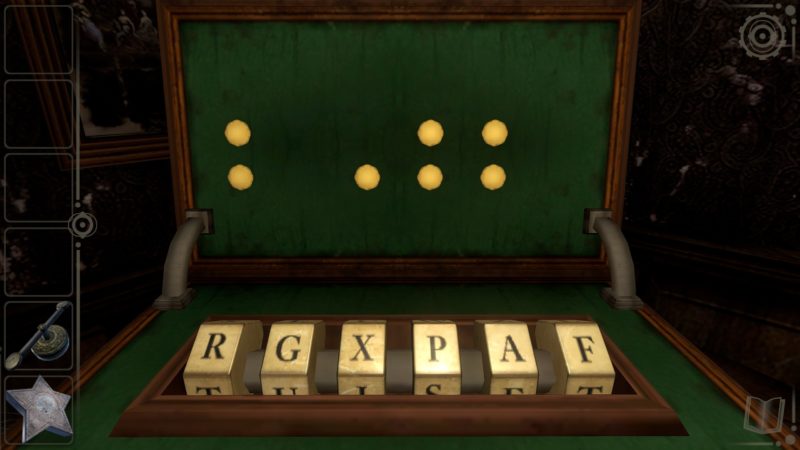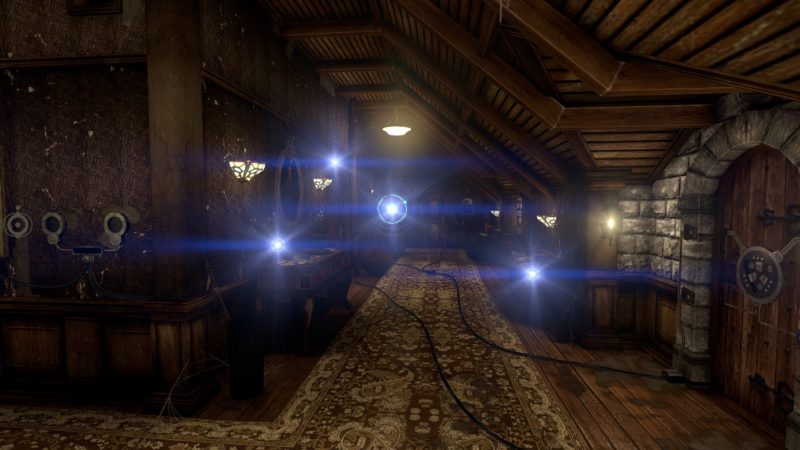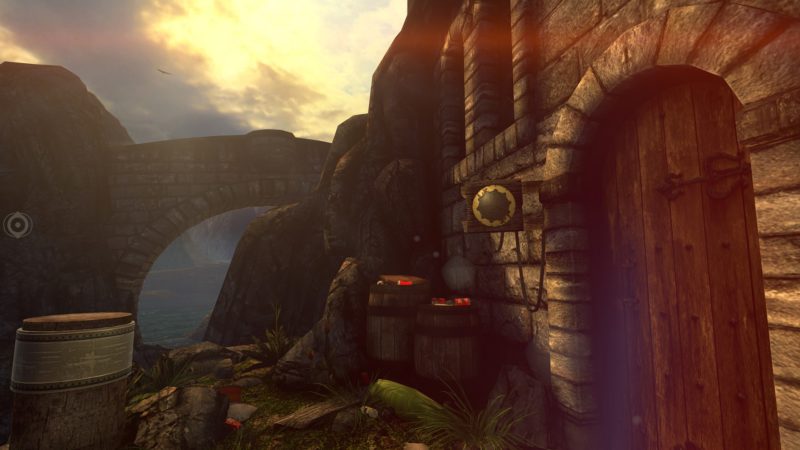
The Eyes of Ara, an adventure puzzle game released in 2016 by independent studio 100 Stones Interactive, has now made the leap to iOS, and what a leap it is! The game is visually stunning, and the story of the world, though somewhat clunky, is interestingly presented to the player through conflicting accounts and partial-truths. The game masterfully manages to create a real and meaningful sense of isolation and feelings of being trapped, giving the abandoned castle in which the game takes place a real sense of character. This proves one of the most effective components of the experience of The Eyes of Ara, as the detail and specificity of the maps and environments ooze character. There’s a sense of history that plays into being in a room or fiddling with the collectibles that can be found littered around each area of the map. The castle feels like a thoroughly designed and very realized place. That is to the game’s credit, given that the player will be maneuvering through an immense number of environments and rooms and keeping track of them proves difficult without necessary background signposts.

While the ability to look around and effectively get a sense of the space you are in is incredibly useful, it proves less supportive in the larger scheme of the game, where you are not provided with a map to navigate the many corridors, rooms, and chambers you will have to explore. Using an iPhone makes this experience even more difficult, as the small screen does little to help with differentiating the elaborate environments of the game world on the fly. This is to the game’s detriment, as it can be a real pain to circumnavigate the sprawling castle while also juggling the puzzles and collectibles littered around each central chapter of the game. Equally problematic for iPhone are the story elements, books, and journals scattered through the game world that are meant to be consumed for backstory and puzzle hints. Small, stylized text does not play well on a small screen with limited resolution. I can see how this played much better on the PC format of the game, but still probably should have been updated to be more legible.

The real draw of the game is its puzzles, which are, to put it mildly, incredible. Woven neatly into the very world design, so that none ever genuinely feel out of place or clunky, the puzzles are the highlight of the game experience and kept me at it long after I should have been asleep or doing other work. They are addictive and will keep you thinking about them and guessing at their correct solution until you’ve finally managed to best any which may have stumped you. Now, upon its initial release in 2016, criticism was leveled at the difficulty of the puzzles involved in the later stages of the game. To be fair, the challenge jumps rather drastically in the later chapters of the game. The game consists of three main chapters (in addition to an opening and epilogue), and each section finds itself growing increasingly tricky with each puzzle completed and each hurdle overcome. The puzzles themselves are incredibly varied and complex, some being merely moving an object to one place or pulling a lever somewhere to open a door, others are far broader in scope and impact. This is where the is at its finest. Many of the mechanisms necessary to accomplish more difficult or long-form puzzles demand an understanding of the machines themselves. This often proves just as challenging as knowing what to do next. So, while the player must accumulate the necessary knowledge, more challenging still, they must then decipher how to apply that knowledge to overcome the many puzzles the game throws your way. The solutions you manage to implement not infrequently produce entirely new questions you have no idea how to answer. Or, more deviously, provide answers to questions the game hasn’t asked you yet. These kinds of tiered puzzles are gripping and engaging, and more than that, incredible fun. When you do finally manage to piece things together, it leaves with an incredible sense of accomplishment.

For example, a puzzle that the player runs into during the first Chapter of the game: they encounter picture frame stands set around the kitchens and back rooms of the main hall. The game gives you no information as to what they are or even where to find the picture frames that fit them, but as you spend time with them, you realize you are missing some necessary piece. Upon unlocking a secret staircase and traveling up to the isolated balcony, you manage to find glass cases with the three frames inside. After opening the cases using a special combination, which you find split into two pieces earlier in the level (which you have up till now been unable to use), you get access to the frames. You start to think you’ve done it, the real trap of this puzzle. Each frame has cycling digital images on them, which if you don’t match to the appropriate room cannot lock the frames into place on their respective stands. The player is never told this. You’re just expected to figure out how to swap through the cyclable images until you realize how they fit into the rooms—which are all themed, naturally. This type of puzzle is incredibly rewarding and lends itself to a real sense of challenge and warranted difficulty. To the game’s incredible benefit, there is never a feeling that the player is being cheated. If puzzles had been done even slightly different, it would entirely throw off the reasonable yet demanding difficulty of the game.

The real shame here then lies in the fact that storyline the players are following, which is selectively walled off by the remarkable puzzles, is itself rather unremarkable. Revealed in journal snippets and books found throughout the castle, as well as within animations involving some of the castle’s only animated inhabitants (notice how I never said people), the game goes for style over substance. These clues and writings are equally frustrating to cycle through with the game’s weak UI. While minimalist, and thus giving the player the ability to thoroughly engross themselves in the game world, the sidebar with puzzle items and clues is hard to move through and ultimately leaves a lot to be desired in the way of organization. A shame, given it is made worse by the small text and rapid scrolling anyone playing on an iPhone will have to do.

Despite this, The Eyes of Ara for iOS is an all-around fantastic experience. True, the story is unpolished and navigating both menus, and the world itself can be unnecessarily laborious, but those deficits don’t come anywhere close to diminishing the pure pleasure it is to play the game. The loving detail in the world art and design, as well as the astounding level of fun and challenge interwoven into painstakingly constructed puzzles, makes for a phenomenal experience. Like any good puzzle adventure game, the star of the show is the puzzles themselves. Furthermore, though exacerbating some of the game’s clunkier features, the iPhone does prove an intimate setting to explore this gameplay experience and tackle the challenges it throws your way. That intimacy does a great deal for player immersion. All in all, the game proves a deserving 8.5/10.
Here is The Eyes of Ara Trailer:
The Eyes of Ara is available on the App Store and Steam.
iOS Review
-
Overall Score - 8.5/108.5/10
I am current Junior at Carnegie Mellon University, and a deep lover of all things gaming and narrative. I play just about every game genre imaginable, but am particularly fond of story driven games and any narrative world where words have more letters than necessary. I am naturally drawn toward RPGs and Action Adventure Games, but am a huge fan of FPS titles, and competitive online games. Also developed a pretty recent addiction to turn-based and 4X strategy games. Shout out to Total War: Warhammer. Some of my favorites of all time include Dishonored, Witcher 3, Undertale, Half Life 2, and What Remains of Edith Finch. I just finished the newest God of War, and that's jumped pretty high on that list as well. As an avid writer and consummate lover of gaming, I hope that my reviews might provide meaningful insight into the games I play, or kick-start a love for narrative and gaming in others!





More Stories
S.T.A.L.K.E.R. 2: Heart of Chornobyl Review for PlayStation 5
Red Dead Redemption and Undead Nightmare Available Now on Netflix, PS5, Xbox Series X|S, iOS, Android, and Nintendo Switch 2
SLEEP AWAKE Review for PlayStation 5